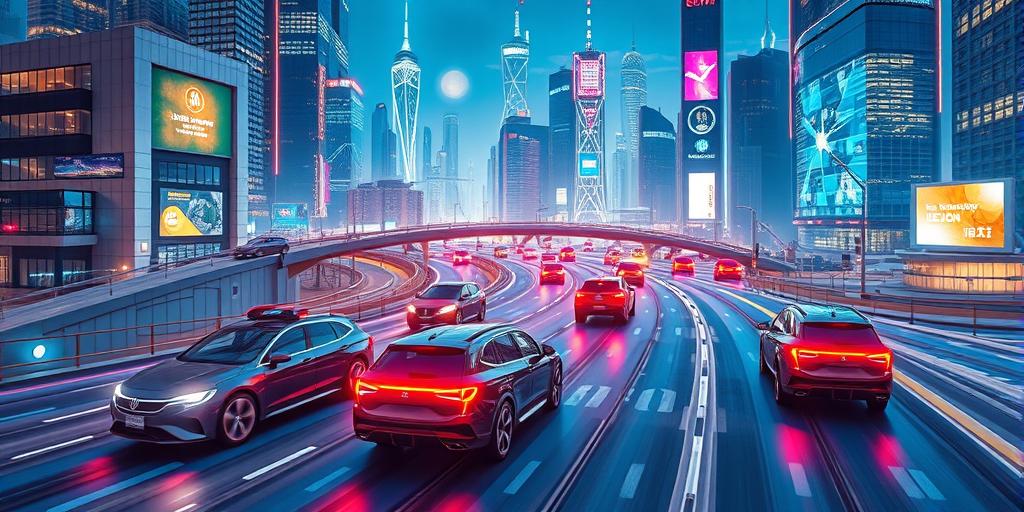Prepare to be amazed! The Internet of Things (IoT) is on the verge of revolutionizing transportation as we know it, paving the way for a future that’s safer, more efficient, and incredibly intelligent. Forget everything you think you know about traffic jams, delays, and unreliable transit systems – the IoT is poised to transform the transportation industry in ways we’re only beginning to imagine. This is your chance to get ahead of the curve and understand how IoT will reshape the future of how we move people and goods around the globe. Get ready to explore the exciting possibilities!
Smarter Roads, Safer Journeys: IoT’s Impact on Road Transportation
Imagine a world where your car communicates directly with the road, anticipating potential hazards and seamlessly adapting to changing conditions. This isn’t science fiction; it’s the reality the IoT is bringing us closer to every day. IoT-enabled infrastructure, including smart traffic lights and intelligent road systems, is already transforming road transportation, making our journeys smoother and more efficient than ever before. The integration of connected vehicles, equipped with sensors and communication capabilities, will lead to fewer accidents and reduce traffic congestion, enhancing safety and optimizing traffic flow. Think of it as a sophisticated, city-wide traffic management system operating in real-time, constantly learning and adapting to minimize disruptions.
Real-time Traffic Management and Predictive Analytics
Real-time data analysis, enabled by IoT sensors embedded in roads and vehicles, offers unparalleled insights into traffic patterns. This allows for dynamic adjustments of traffic signals and routing strategies, reducing congestion and improving journey times. Predictive analytics, using historical and real-time data, can foresee potential traffic bottlenecks and proactively deploy solutions, preventing major delays. This proactive approach leads to reduced fuel consumption and emissions, contributing to a more environmentally friendly transportation system. With less idling, we’ll see significant improvements in air quality, leading to healthier cities and a better overall quality of life.
Advanced Driver-Assistance Systems (ADAS) and Autonomous Vehicles
The convergence of IoT and ADAS is leading to safer and more convenient driving experiences. IoT-connected vehicles share real-time data about road conditions, potential hazards, and the location of emergency vehicles, enhancing the capabilities of ADAS features like lane departure warnings, automatic emergency braking, and adaptive cruise control. As autonomous vehicles become more prevalent, the IoT will play a critical role in their safe and efficient operation, allowing them to communicate seamlessly with other vehicles, infrastructure, and pedestrians, creating a safer and more coordinated traffic flow.
Revolutionizing Public Transportation: An IoT-Powered Upgrade
Public transport is getting a serious upgrade thanks to IoT technology. Smart buses, trains, and trams equipped with sensors and communication networks are providing real-time tracking of vehicles, optimizing routes, improving passenger information systems, and enhancing overall operational efficiency. The ability to monitor the health of the vehicle and predict potential maintenance needs minimizes unexpected breakdowns and delays, improving the reliability and convenience of public transportation services. Think of smooth, on-time arrivals, accurate scheduling, and personalized travel updates – the stuff of public transport dreams!
Improved Passenger Experience and Enhanced Safety
IoT-enabled systems ensure seamless travel experiences with accurate real-time information about arrival times, delays, and routes, enhancing convenience and reducing passenger frustration. Real-time passenger counting systems optimize resource allocation, reducing operational costs and improving service efficiency. Enhanced security systems, utilizing IoT sensors and cameras, improve the safety and security of passengers and vehicles, making public transport safer than ever before.
Optimized Resource Management and Reduced Operational Costs
The ability to monitor and manage resources in real time allows for significant cost reductions. Predictive maintenance helps minimize unplanned downtime and reduces maintenance costs. Optimized routing and scheduling minimize fuel consumption and improve operational efficiency. This leads to substantial savings for transit authorities and taxpayers alike, resulting in more sustainable and affordable public transportation systems.
The Future is Connected: Exploring Emerging Trends in IoT Transportation
The potential of IoT in transportation extends far beyond what we currently see. Emerging trends like smart parking systems, drone delivery services, and intelligent traffic management systems will redefine transportation logistics and urban planning. The convergence of IoT and artificial intelligence (AI) will further enhance the capabilities of transportation systems, making them even more efficient, intelligent, and responsive to changing needs. The future is connected, and the IoT is leading the charge.
Smart Parking and Drone Delivery: The Next Generation of Logistics
IoT-enabled smart parking systems utilize sensors to detect available parking spaces in real time, guiding drivers to open spots and reducing traffic congestion caused by circling drivers searching for parking. Drone delivery services, facilitated by IoT communication networks, offer faster and more efficient delivery of goods and packages, especially in congested urban areas. These technologies combine to improve the overall efficiency of urban logistics.
AI-Powered Transportation Systems: Smart Cities, Smart Mobility
The integration of AI and IoT in transportation systems will lead to the creation of intelligent, self-optimizing transportation networks. AI algorithms analyze massive amounts of real-time data to dynamically manage traffic flow, optimize routes, and improve overall operational efficiency. This data-driven approach ensures the transportation system adapts to fluctuating demands and evolving conditions, making our transportation networks smarter and more responsive than ever before. The creation of truly smart cities relies heavily on this emerging technology.
Get ready for a future where transportation is not just about getting from A to B, but about a seamless, integrated, and intelligent experience. The IoT is here, and the transformation has already begun! Embrace the future of smart transportation today!




